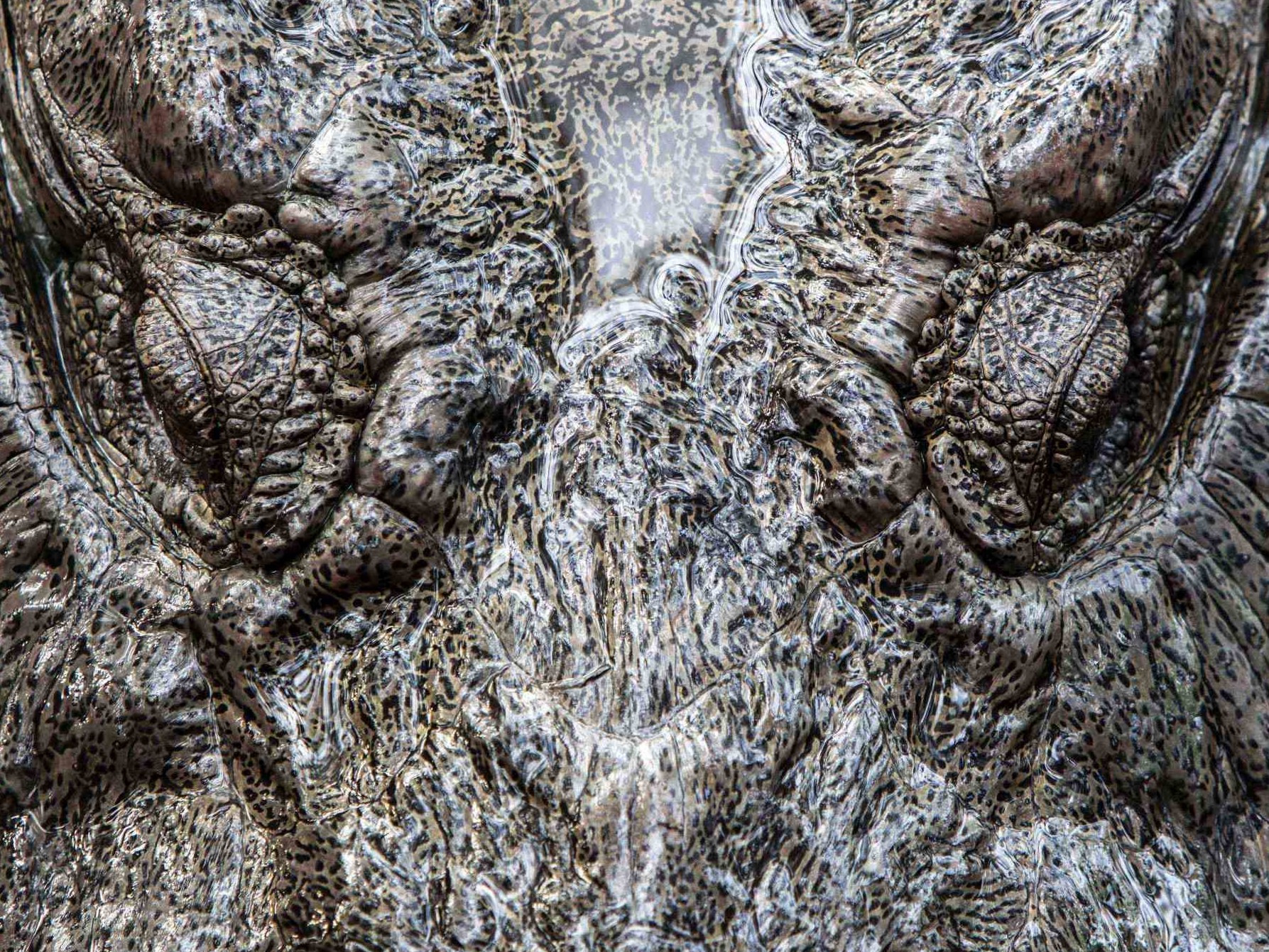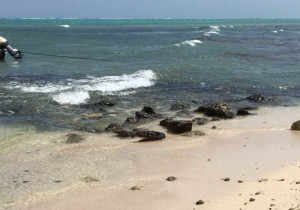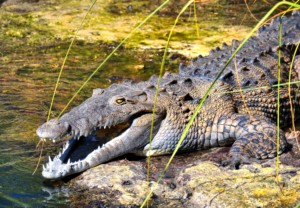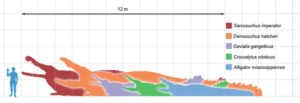My wife, Susan, claims to be afraid of crocodiles.
I find this charming, because it brings to exactly three the number of things I can name that Susan is afraid of. The other two are bears, because she’s been attacked by one, and clowns, because—well, that one needs no explanation.
But I’m not sure I’m buying her profession of fear where crocodiles are concerned. For one thing, it hasn’t kept her from kayaking among them on two occasions I can name (and probably a few we weren’t aware of). And also, when I spotted the crocodile in the photo below, from the deck of the Casa Cenote restaurant a little south of Akumal, it was Susan who gleefully grabbed my iPhone and set out to see if she could get a little closer for a decent snapshot.
Can you find the crocodile in this snapshot?
Photo by Susan Fry
I say when I spotted it—actually nothing happened until a good five minutes after I spotted it, because I just sat there for the longest time not saying a word. You see, my life has been a cyclical process of painfully gaining a little credibility, and then squandering it all in a flash by saying something radiantly stupid, so my brain has stepped in and developed a defense mechanism to protect me from that. My brain now requires redundant fact-checking, and re-analysis from multiple perspectives, before it will allow my mouth to open and say something like, “Hey, guys, there’s a crocodile on the beach.”
I finally said it, though, and all the heads turned.
“Just past those sunbathers there. See it?”
Everyone peered out where I was pointing.
“Look about a hundred feet beyond that woman without the, uh, whatever you call that thing she’s not wearing.”
Everyone squinted.
“It looks a lot like the rocks. Really, it’s there.”
I thought I’d gone and done it again, but finally someone said, “Oh my God, he’s right!” and I sighed and sat back, saved again.
My assessment of how scary crocodiles are isn’t as interesting as Susan’s, because I’m just a normal guy with a whole closetful of normal fears, but for what it’s worth, I have to agree with her: There’s something about a crocodile. They slip into the water and you don’t know where they’ve gone, they attack from below, they have reptilian brains and vertical pupils and they look largely like they did when dinosaurs were walking the earth. There’s just something about the crocodile that makes you shudder. But to me, what is most unnerving about them is not that they are brute, prehistoric, instinct-driven killing machines.
It’s that they’re a lot smarter than you think they are.
* * * *
A while ago when an asteroid seven and a half miles across hit the earth 150 miles northwest of Akumal, everything large that was walking on the surface of the planet perished except the crocodiles. They were the largest vertebrate to survive that extinction event. So although they are classified as reptiles, scientists will tell you they are more closely related to dinosaurs and birds than they are to modern reptiles, and one thing they have that lizards do not is a cerebral cortex.
That makes them capable of a whole range of things that don’t seem terribly brute. They can do pattern recognition. If you’re an animal who tends to come down to the water’s edge at around the same time each day, they’ll figure you out, and lie in wait for you. If you’re lucky, the nostrils and eyes might be showing, but they might also be completely submerged, which is something they can do for up to fifteen minutes routinely, a couple of hours in a pinch. When the herons are building nests in the mangroves, they will decorate their snouts with sticks and twigs—and they know exactly what types sticks and twigs the birds are looking for. When the heron lights briefly to grab a choice one, that’s the end of that story. They can hunt cooperatively, circling around schools of fish to concentrate them, and then taking turns lunging in for a bite; or bringing down a large animal as a group effort, with one crocodile holding it down for the others to dismember. They have elaborate mating rituals, and a complex communication system involving a variety of sounds including chirps, whistles, hisses, and a low-frequency mating “bellow.” They are devoted and fiercely protective parents. They have the most complex behavior of any reptile, and they can be very social—but only when they’re in a social mood. When they’re not, there can be cannibalism. One nine-foot crocodile was found in Honduras with a five-foot crocodile in its stomach. Of the same species.
American Crocodile (Crocodylus acutus)
By Mattstone911 (Own work) CC BY-SA 3.0 http://creativecommons.org/licenses/by-sa/3.0 via Wikimedia Commons
When you read up on crocodiles, half the articles you come across are biased one way or the other. They are either edge-of-the-seat thrillers about what savage killers they are, or they are fru-fru pieces about how they’re actually caring, intelligent, misunderstood and in need of a hug. Clearly what’s being provided by these articles is a look into our own minds. So what I’m going to try to do here is write a clear-eyed article about crocodiles. Open your round pupils and enjoy, because they are absolutely amazing for exactly what they are—and are not.
* * * *
The crocodile we get here on the Caribbean coastlines is the American Crocodile (Crocodylus acutus), and they’re not that hard to see around here. They love mangroves, estuaries and river mouths, so Sian Ka’an is great crocodile habitat. There’s a good-sized one that hangs out in the mangroves beneath the Boca Paila Bridge. They can approach twenty feet long and a couple thousand pounds, but fifteen feet is more normal. If you’re like most people who see that photo up there, you were surprised that a crocodile would be friendly enough with saltwater to hang out on a beach. Well, don’t feel too out-of-step—scientists hadn’t fully appreciated it either until fairly recently. It was always known that they sort of tolerated a little brackishness out of necessity, but it’s becoming more clear that they actually prefer it, and that they are full-on marine animals, with desalinators under their tongues, and the ability to make a living on tiny cayes and islands without a drop of fresh water around. They’re also learning that they can navigate long distances at sea. A hybrid of the American and the Cuban crocodile recently showed up in Cancun, and the only place those hybrids exist is in a swamp on the south coast of Cuba. Just the strait between Cuba and Cancun is 125 miles of open water. They also seem to have homing skills, and relocated crocodiles have returned 250 miles to their childhood stomping grounds.
Their mating and child-rearing behavior is a wonder, and amazing by reptile standards. They’ll start courting with the bellowing I mentioned, and when they find each other the male will do some head-slaps. If the female is turned on by this, she’ll arch her head and tail upward, and then the male vibrates his entire body in a complex display. Then they rub snouts, ride each other around, blow bubbles and seemingly have a great, playful time of it, and finally the male grasps her from the side, everts his penis, which was tucked inside him but is constantly erect, and he penetrates her.
When she lays the eggs (there will be from 30 to 80 of them), she digs a nest for them, and it’s worth remembering that she will usually be in a burrow nearby, ready to defend them. You’d think that would give pause to the nest raiders, but the mangroves are just full of animals ballsy or hungry enough to try it, and raccoons, coatis, foxes, skunks, vultures and iguanas are all known to give it a shot in a pinch. With mixed results.
And this is my favorite part: They will often cover the nest with vegetation, which will generate heat as it composts. I kid you not—they know how to build a compost heap. I’ve been trying to make a compost heap work since the seventies, but the crocodiles have had it dialed in since the Cretacious. The reason for this trick is that crocodiles do not have sex chromosomes. Instead, sex is determined as the fetus develops in the egg. Each fetus can go either way, and it’s controlled by temperature. At 86 degrees Fahrenheit and below you’ll get mostly females, but by 91 or 92 you’ll be getting mostly males, and evolution just hates single-gender situations, so the crocodiles carefully avoid a one-gender clutch.
When the eggs are ready to hatch, the babies will call out to their mom from within the eggs and the mother will assist them in breaking out, by rolling them around in her mouth, and then she’ll carry the hatchlings to the water, and continue to watch over them and even feed them for several weeks. If she’s not around the male may step in.
She may also carry the hatchlings some distance, even a mile or two, to get them to a good, safe nursery habitat. They will be in her mouth, peering out from between her teeth. The hatchlings have a ton of predators, but I guess there’s not a much safer place to be than inside the mouth of a large crocodile, depending on your relationship with the crocodile. Crocodiles are better at travelling overland than you might think. With their “belly walk,” which is a slithering motion with their legs out to the sides, they can hit eleven miles per hour, which is roughly as fast as you can run. But they also have a “high walk,” in which their legs are under them and their bodies are off the ground, and some species can even gallop. But really they are at their best in the water, where they accelerate with their tails, brake with their webbed feet, and are capable of powerful lunges and speeds of twenty miles per hour.
They are nocturnal, which is why they have vertical pupils. Vertical pupils are an interesting adaptation—they actually evolved to help night hunters get through the day—they are better at excluding light from those extra-sensitive eyes. Their eyes have rods and cones, so they probably see in color. They tend to hunt in the first few hours of darkness, and they prefer moonless nights. They will lurk by a shoreline with nothing showing but the tiny bumps of their nostrils and eyes, and explode out at prey that comes down to the water’s edge. They prefer medium-sized mammals, reptiles and fish, but they’ll take down a large animal if they need to, including deer, peccaries and livestock. They have four-chambered hearts (also rare in reptiles), a high level of control of the oxygenation of their blood, and when they stay submerged for longer periods, they slow their hearts to a few beats per minute and shut down blood flow to non-essential organs. By the time they attack, their blood might contain mostly CO2, and then they do something extremely cute: They close a valve in their heart called the aortic arch, with the result that all that CO2-rich blood floods directly out of their muscles into their stomachs, and all that CO2 hugely increases the acidity of their digestive juices. They have the most acidic stomachs of any vertebrate, and can easily digest things like horns, hooves and turtle shells.
And it is absolutely true that they are fairly fearsome creatures. They have by far the most powerful bite of any animal, whether mammal, reptile or fish. There are five thousand pounds of force in the jaws of an American crocodile, and if you think that’s scary, be glad you weren’t around in the Cretacious period. Their ancestor Sarcosuchus lived in the lush, green wetlands and river systems of what is now the Sahara Desert, and it kept growing all its life (it’s called indeterminate growth), and could reach forty feet and ten to fifteen tons, and scientists think it probably had a bite force of twenty-three thousand pounds, from what they can tell by analyzing fossil jaw structures. That’s more powerful than any dinosaur, including Tyranosaurus Rex, but hey, T. Rex was not the largest meat-eating dinosaur that ever lived. That would be his relative Spinosaurus, who actually co-existed in those Saharan wetlands with this crocodile, and competed with him for prey. Scientists think there were probably some epic battles between the two that Steven Spielberg would have loved to film.
Sarcosuchus
By Matt Martyniuk Dinoguy2 (work done by author) [CC BY-SA 3.0 (http://creativecommons.org/licenses/by-sa/3.0)], via Wikimedia Commons
But for all that bite force, there are a couple of abilities crocodile jaws don’t have. They can’t shear meat. All their teeth are dagger-shaped things that hold but don’t cut, so they kill their prey by clamping down on it, which their jaws are very good at, and then rolling to rip it apart. People call it the death roll, but death is not instantaneous, and usually comes only through bleeding or drowning. As death by a predator goes, there are easier ways to die. A crocodile killing is, well, messy and protracted.
The other thing their jaws are not good at is opening. They are fearsomely good at closing them—most of the bulk you see in a crocodile’s head is those muscles, and they say that when you touch them they feel like bone—but the jaw-opening muscles are tiny, which is why researchers can safely work with a large crocodile by simply taping its snout shut. (Of course, getting that tape around the snout is a dicier proposition.)
* * * *
So on to the big question: Are they dangerous to humans? The answer is yes. They definitely are. The Nile crocodiles of northern Africa and the saltwater crocodiles of Australia are worse, but American crocodiles are plenty worthy of respect. There have been 36 crocodile attacks in the Cancun area since 1995, though fatalities are rare. Most are in the Nichupte Lagoon, which is the large body of water between the hotel strip and the mainland. There are warning signs all up and down that road. To stay out of trouble with crocodiles, all you really need to be is non-stupid, but that doesn’t seem to exclude a lot of folks. Back in July a drunk tourist waded into the lagoon in the middle of the night to pee and lost an arm. In 2015 a man, also intoxicated, was pulled under and killed. His body was found floating the next day. This is why it’s an extremely bad idea to feed crocodiles, which is commonly done around here for the amusement of the tourists. It’s a bad idea because it teaches the crocodiles that (a) people are no threat, and (b) people mean food, and those are two thoughts you don’t want rubbing together in the cerebral cortex of a crocodile.
But it’s important to keep these things in perspective. By far the animal that causes the most human deaths on this planet is the mosquito.
And it is followed as a close second by our own sweet selves.
Now you know.
Copyright © 2017 Randy Fry
Sources:
-http://crocdoc.ifas.ufl.edu/publications/fieldtrips/nestingcrocodiles/
-http://crocodilian.com/cnhc/csp_cacu.htm
-http://www.bioone.org/doi/abs/10.1656/058.013.0407
-http://www.mypalmbeachpost.com/business/researchers-wary-crocodile-nests-hatchlings-drop-fpl-nuke-plant/11t8eEnauDDG1kCZhWVeCM/
-https://www.riviera-maya-news.com/tourist-loses-arm-to-crocodile-attack
-https://www.gatesnotes.com/Health/Most-Lethal-Animal-Mosquito-Week
-https://www.sciencedaily.com/releases/2016/05/160520102244.htm
-http://www.newsweek.com/nile-crocodile-florida-study-463598
-http://www.utne.com/arts/being-prey
-https://www.thoughtco.com/prehistoric-crocodile-profile-4047616
-https://blogs.scientificamerican.com/tetrapod-zoology/saltwater-crocodile-crocodiles-part-iii/
-http://crocodilian.com/cnhc/cbd-faq-q5.htm
-https://www.ncbi.nlm.nih.gov/pmc/articles/PMC1931431/
-https://www.ncbi.nlm.nih.gov/pmc/articles/PMC4406946/
-https://www.thoughtco.com/facts-about-sarcosuchus-worlds-biggest-crocodile-1093333
-https://www.thoughtco.com/spinosaurus-vs-sarcosuchus-who-wins-1092435
-http://phenomena.nationalgeographic.com/2015/01/13/great-galloping-crocodiles/





Thanks, Roni!
0400 on the central coast of Cali: I woke up thinking about randy and Susan and that photo you sent me – “She blew up her TV”…
Very glad to find you, and your writings, through the Web. I get to be high- centered for a bit (months) on the far south coast of Big Sur. When are you ‘stateside’ -? – what do you call a US visit? Know I love your writing and send Best Regards!
Hey, Katy, great to hear from you! I’ll email you so we can chat!
Enjoyable and enlightening, as usual. Thanks.
Thanks, June!
I truly enjoy your writing style, Informative and fun to read.
Thanks, Barry!
Randy, soooo good to read you again, I miss you and Susan down there. Aline is here in Connecticut till November , We will both be down there in our natural, almost ,environment for the winter. Thank you for this very informative read . Best wishes Thomas
Great to hear from you, Thomas! Look forward to seeing you two again!
Randy, Always interesting to read your well-researched and well-presented articles.
Now I know 🙂
Hari
Hey, great to hear your voice, Hari! Hope all’s well with you!
Loved this article! Every time I read one, I think “He needs to write a book!”.
I’m glad to read that you and Susan are still enjoying your time there.
Thanks, Randy! Hope you two are doing well also! Say hi to everyone!
Captivating, as always. thanks for sharing your knowledge in such delightfully readable ways.
Thanks, Gail! Hope you’re well!
GREAT piece!!
Another brilliantly written eye-opener, through the reading of which I become ever-so-slightly less ignorant.
Thanks, By!